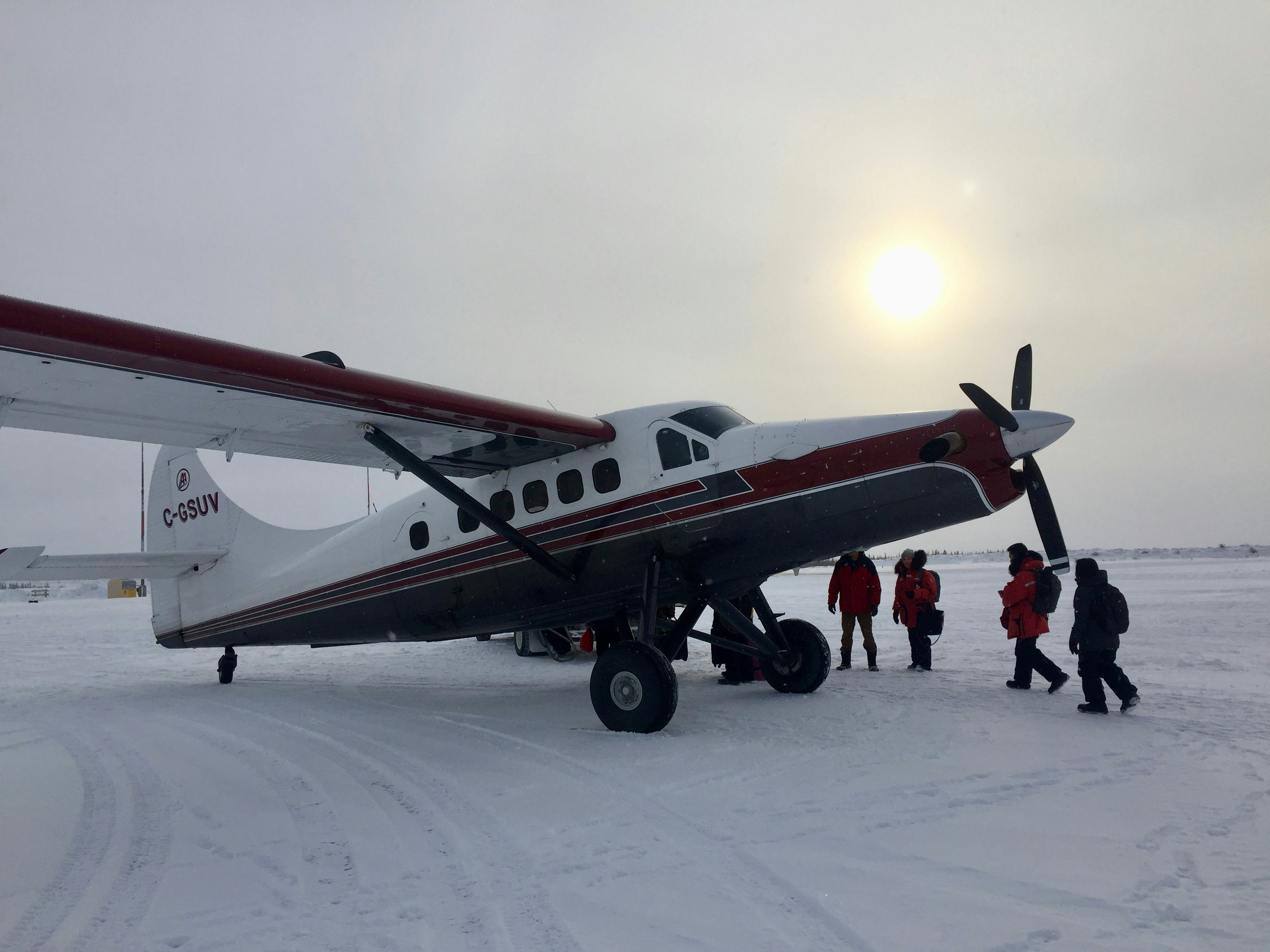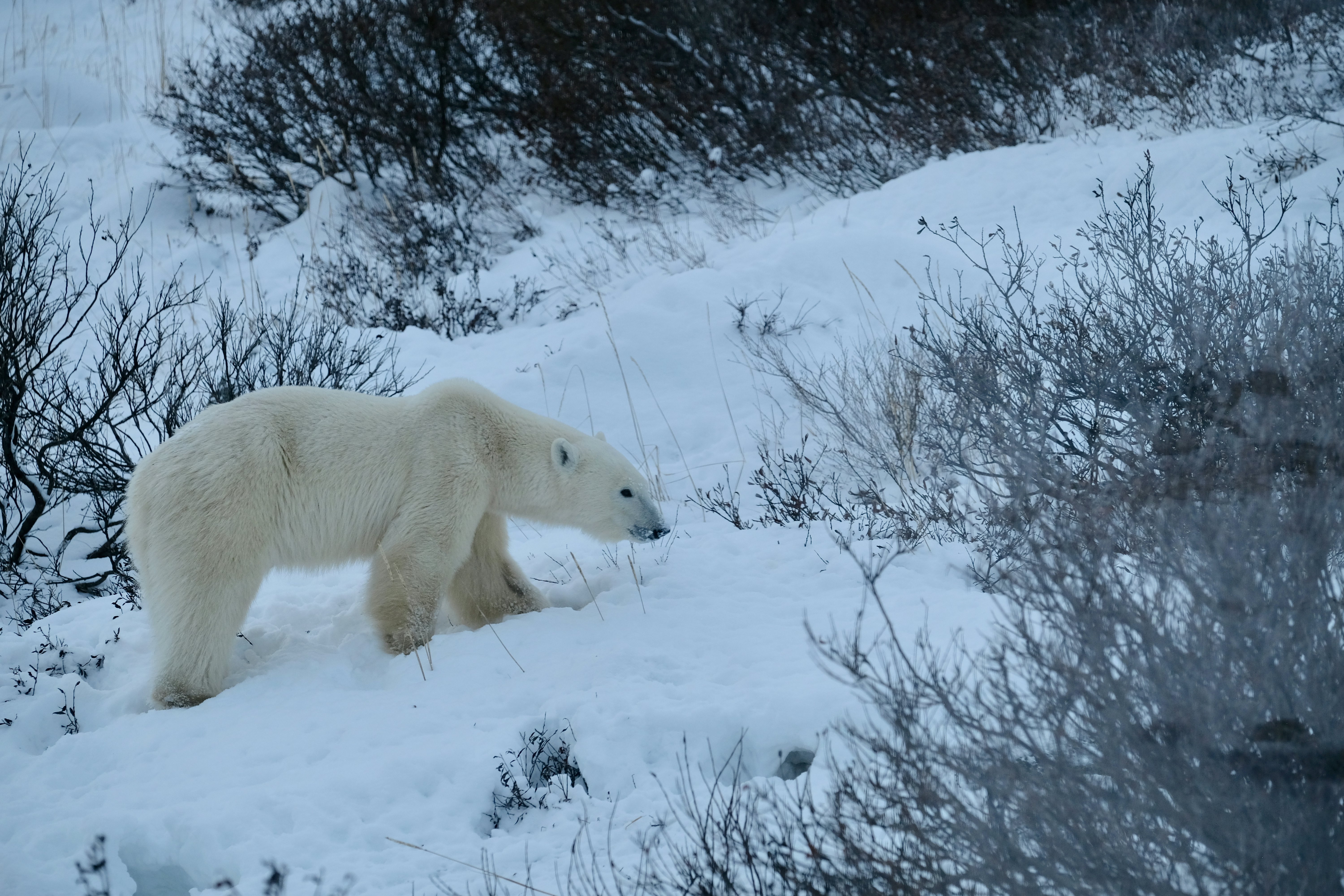Canada’s best polar bear experiences aren’t where you think they are
Feb 21, 2020 • 5 min read

In early November the western shore of Canada’s Hudson Bay is a jumble of new ice and ancient boulders. Dusted with fresh snow, it’s a dramatic palette of black and white, made even whiter by three frisky Arctic foxes playing tag in front of Seal River Heritage Lodge.
We’re looking out of the lounge’s big windows and laughing at the foxes’ antics when suddenly our mood turns serious. Striding across the rock-strewn beach on big furry feet is one of the largest land carnivores in the world.

This is what we’re here for: to see and walk with polar bears in Canada, the country that’s home to about two-thirds of the estimated world population of 23,000 polar bears.
Still, it’s startling the first time you see a polar bear in the wild walking towards you. We watch in silence and in a matter of minutes she’s standing just metres away. Even through the windows, we’re transfixed by her powerful presence and probing black eyes. She sees us, but doesn’t show any fear as she sniffs the ground where the foxes played moments earlier. Then, she turns and keeps walking north and we let out a collective breath of wonder.

How to walk with polar bears
Polar bears live throughout the Arctic, but the western shoreline of Hudson Bay is believed to have the largest concentration anywhere, between 800 and 900.
It’s got a lot to do with the way the wind blows and the ice floes. Every year in late spring, wind and currents push ice floes carrying bears into the southwest corner of the enormous bay. When the ice melts, the bears have no choice but to go ashore.
While waiting for the next freeze-up, they walk north, passing the port town of Churchill – the ‘polar bear capital of the world’ – and three Churchill Wild eco-lodges strung along the coast. Churchill Wild offers walking tours with polar bears at all three lodges every July through November.

You might also like: Where to see polar bears in the wild
“All my life I avoided polar bears,” chuckles Norman, a Cree guide at the Seal River Heritage Lodge. Coming here, he confides, “it seemed crazy at first to be following them.” And yet that’s what we’ll do each day for four days.
“We won’t walk straight up to a bear,” explains Andy, the lead guide, during an orientation session on the first day. Instead, we’ll approach indirectly in single file so we look like one long body.
“We want to show him how big we are,” adds Andy, just like a male bear will turn sideways to show another male how big he is.

The three guides on our twice-daily walks carry shotguns, but in the 26 years since Churchill Wild introduced walking with polar bear tours, they’ve never had to shoot one. Andy can’t remember the last time he even used bangers or screamers, deterrents that are commonly used in Churchill to scare bears away.
Instead, the first line of defense here is simply to speak firmly to an overly curious bear. “It’s just like talking to your dog,” says Andy, “I’ll raise my voice.”
Oddly enough, it’s foxes, not bears, that I fall asleep thinking about that night. Just before I turn in, I find them playing again under the outdoor spotlights. Falling snow swirls around them, like they’re inside a giant snow globe. But instead of a traditional and tranquil winter scene, the foxes race around like Wile E Coyote chasing Road Runner. Hilarious!

You might also like: Canada’s best wildlife experiences
Diverse wildlife watching in Hudson Bay
The next morning the temperature has plummeted to almost minus-20°C. The foxes are curled up in a bank of snow, sound asleep, their small black noses tucked under bushy tails.

We gather outside too, dressed in fur-trimmed parkas and puffy down jackets. With our faces covered with balaclavas to protect us from the biting cold, I can only guess who’s who.
Of the 15 guests, there are seven Americans, three Aussies, a couple of Brits, two Israelis, and a single Canadian. We’re old and young, including two mothers with their adult sons. One elderly woman has chosen to stay inside and watch life unfold through the windows.
“We’re going to explore the ridge and along the shoreline,” Andy tells the rest of us. “That’s where they like to bed, out of the wind. We’ll go nice and slow.”

On this walk, the only life we see is a wily wolverine and a flock of ptarmigan in winter plumage, so white it’s hard to spot them in the snow. On subsequent days we see equally white Arctic hares and lots of foxes, some red, some a cross between black and red. We take lots of photos, but none of bears.
On our second last day I’m enjoying a bowl of steaming oatmeal in the dining room when Andy invites me to look through his powerful scope. About a kilometre away a mother bear is curled up with her cub in what looks like a nest of seaweed.

Soon we’re off, the only sound the crunch of snow under our heavy boots. We stop about 70m from where the mother and cub are resting.
“We don’t need to get any closer,” whispers Andy. “She’s super relaxed right now.” The bears don’t budge for at least 15 minutes. My fingers and toes are tingling from the cold when they finally rise, stretching and yawning, just like a person waking from a nap. For powerful predators, they sure look harmless.
The next morning we’re packed and ready for our short flight back to Churchill when guess who comes to see us off? At least that’s how it feels.

Outside the safety fence surrounding the lodge, the mother and cub we watched the day before are browsing in some willows. They’re picture perfect, the sun illuminating their gentle faces and ivory fur. They practically pose, giving even the amateur photographers amongst us time to take photos.
And then they saunter off, leaving us awestruck once more.
You might also like: Canoe Canada's wilderness on these iconic waterways
Plan with a local




